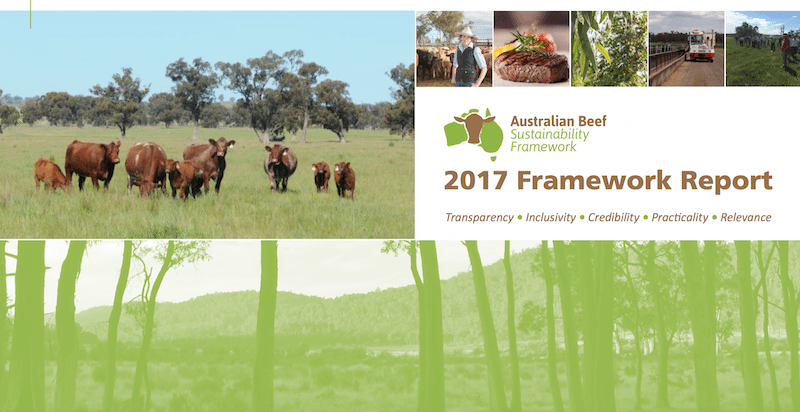The first Australian Beef Sustainability Framework – a guide for the industry to use when monitoring, measuring and reporting sustainability – has been formally released by the Red Meat Advisory Council today.
The Framework has been developed by the Sustainability Steering Group (SSG), following a year of consultation with industry, retailers, regulators, banks, investors, interest groups, customers and the community.
It lists 23 priority areas to enhance animal wellbeing and health; increase profitability, productivity and market access; improve land management, address climate change and minimise waste; produce safe and nutritious food, build workforce capacity and ensure the health, safety and wellbeing of people in the industry.
A draft version of the framework was released in January.
Public, industry and stakeholder consultation feedback has resulted in some changes, including:
- The wording of the Vision has been adjusted to include the words “striving for continual improvement”, recognising concerns in industry that not all indicators will be able to continually improve.
- The framework tables now include explanations of the indicators and priority areas to clarify the intention and explain their relevance.
- In the priority area “manage climate change risk”, sequestration has been updated to reflect that while there isn’t agreed methodology, that the beef industry is unique in its ability to sequester carbon through effectively managing the integration of soil, water and plant assets assists in reducing CO2 emissions.
- Animal husbandry techniques have been added back into the framework (this was in previous versions before the online consultation version). The indicators under this are poll gene, and use of pain management.
- Deforestation has been removed as a stand-alone priority area and replaced instead with Balance of tree and grass cover. The SSG believes this enables industry to tell the story that in much of northern Australia managing regrowth is a good environmental and productivity outcome. Indicators in this area are maintaining grasslands from unproductive encroachment and introduced species; no deforestation of primary forests; increase in healthy grasslands systems and area of native vegetation managed for conservation purposes.
- An additional indicator was added to track the people & community theme, recognising feedback on the importance of on-the-job training. Formal training was removed, as this was not clearly defined.
Red Meat Advisory Council chair Don Mackay said Australian cattle industry recognised that consumers and the community have changing expectations of their industry.
“We want to satisfy the community – and ourselves – that we are doing everything possible to ensure the longevity of the businesses, the families and the communities the Australian beef industry represents,” Mr Mackay says.
“We must be vigilant and able to respond to any risks or opportunities as an industry.
“That is why the launch of the Framework is accompanied with the clear, forward strategy and a robust governance framework that is focused on driving action and delivering outcomes for Australian beef businesses from the farm, to feedlots to processors.”
Implementation for the framework will be addressed through a 5-point action plan that will engage the right people to tackle sustainability challenges for the sector, pinpoint key additional information required; and continuously report back to the industry and community (see page 7 of the report).
“The Meat Industry Strategic Plan 2020 shows us if we do everything right; we can add up to $7 billion in value to the sector; but done wrong we can lose up to $6 billion in value,” Mr Mackay said.
“The ASBF helps us strategically and aggressively address these risks.”
SSG chair Prue Bondfield described the Framework as a snapshot of the industry, reflecting the priority areas of customers and stakeholders.
It provides a guide for the industry to use when monitoring, measuring and reporting sustainability.
“The Framework is not an on-farm certification system. No input is required from individual farms. Nor is it a scheme that creates paperwork or costs through the value chain. Existing data will be used where possible.
“This report really marks the start of measuring our sustainability. It was always intended to be a living document open to regular review and adjusted in response to the needs of industry and the expectations of customers and the community.”
“Continued constructive engagement between industry and external stakeholders will ensure that we deliver on our vision in the framework for a thriving Australian beef industry that strives to continuously improve the wellbeing of people, animals and the environment.
“Within the report there are only a few indicators that currently have measures against them.
“There are some indicators that require a small amount of work to develop measures, which will occur over the next year.
“For others where there is currently no way of capturing the information, industry will assess the cost and benefit of investment to develop a measure.
“Rather than focusing on the data, the first report has always been about identifying what is important in sustainable beef production. From here we can work with our stakeholders to understand what areas are the highest priorities and develop action plans. “
Source: RMAC. To read the full report visit www.SustainableAustralianBeef.com.au

